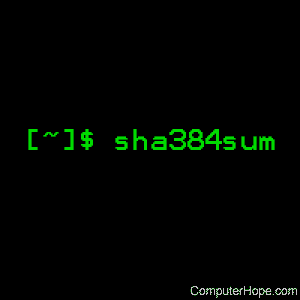Linux sha384sum command

The sha384sum command computes and checks a SHA384 encrypted message digest.
Description
The sha384sum command displays or checks SHA384 (384-bit) checksums. With no FILE, or when FILE is - (a dash), the message digest is read from standard input.
Syntax
sha384sum [OPTION]... [FILE]...
Options
| -b, --binary | Read in binary mode. |
| -c, --check | Read SHA384 sums from the FILEs and check them. |
| --tag | Create a BSD-style checksum. |
| -t, --text | Read in text mode (default). |
There is no difference between binary and text mode option on GNU system.
The following four options are useful only when verifying checksums:
| --quiet | Don't print OK for each successfully verified file. |
| --status | Don't output anything, status code shows success. |
| --strict | Exit non-zero for improperly formatted checksum lines. |
| -w, --warn | Warn about improperly formatted checksum lines. |
| --help | Display this help and exit. |
| --version | Output version information and exit. |
The sums are computed as described in FIPS-180-2. When checking, the input should be a former output of this program. The default mode is to print a line with checksum, a character indicating input mode ('*' for binary, space for text), and name for each FILE.
Examples
sha384sum example.iso
Running the above command would give the SHA384 checksum of the example.iso file in the current directory. Below is an example of how the output may appear with the full SHA384 checksum followed by the file name.
38b060a751ac96384cd9327eb1b1e36a21fdb71114be07434c0cc7bf63f6e1da274edebfe76f65fbd51ad2f14898b95b example.iso
Related commands
md5sum — Checks the MD5 message digest.
sha224sum — Checks the SHA224 message digest.
sha256sum — Checks the SHA256 message digest.
sha512sum — Checks the SHA512 message digest.
